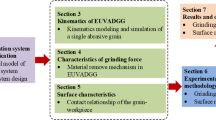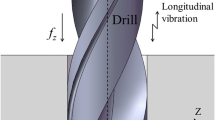Abstract
Grinding wheel dressing is the key to achieving precision form grinding of GCr15 bearing rings. However, the low dressing accuracy and poor dressing quality of grinding wheels using conventional roller dressing (CRD) are problems that need to be solved urgently. A longitudinal-torsional ultrasonic-assisted roller dressing (LTUARD) method is proposed to achieve high precision and high-quality grinding wheel dressing. A device of LTUARD was developed to investigate the dressing effect of the longitudinal-torsional ultrasonic-assisted roller on the white alumina (WA) grinding wheel. The longitudinal-torsional horn with roller loading was mainly studied during the device development of LTUARD. The geometric dimensions of the longitudinal vibration horn with the large tool head were firstly determined by the set of transcendental equations, and then, the longitudinal vibration was converted to longitudinal-torsional vibration by adding a helical slot in the conical section. Subsequently, the resonant frequency of the LTUARD vibration system was found to be 19827 Hz, and the amplitude ranges of longitudinal and torsional vibration were 0~3 μm and 0~1.2 μm, respectively, through impedance analysis and vibration characteristic testing. The results of dressing and grinding experiments show that the roundness error of WA grinding wheels using LTUARD is 8.55 μm, which is 41.56% less than CRD. The surface roughness Ra of GCr15 bearing rings ground by the WA grinding wheel after LTUARD is 0.32 μm, which is 15.79% lower than the surface roughness Ra ground after CRD, and the surface quality of GCr15 bearing rings ground by the WA grinding wheel after LTUARD dressing is better. The reliability and practicality of the developed dressing device were verified by the results of dressing and grinding experiments.













Similar content being viewed by others
References
Jouini N, Revel P, Thoquenne G (2020) Influence of surface integrity on fatigue life of bearing rings finished by precision hard turning and grinding. J Manuf Process 57:444–451. https://doi.org/10.1016/j.jmapro.2020.07.006
Peng YF, Wang ZZ, Yang P (2020) Grinding and dressing tools for precision machines. In: Precision Machines, 1st edn. Springer, Singapore, pp 233–263
Rowe WB (2013) Principles of modern grinding technology. In: Grinding Wheel Dressing, 2nd edn. William Andrew, USA, pp 63–82
Wang JH, Zhao QL, Zhang CY, Guo B, Yuan JL (2020) On-machine precision form truing and in-situ measurement of resin-bonded spherical diamond wheel. Applied Sciences 10(4):1483. https://doi.org/10.3390/app10041483
Deng H, Xu Z (2019) Dressing methods of superabrasive grinding wheels: a review. J Manuf Process 45:46–69. https://doi.org/10.1016/j.jmapro.2019.06.020
Nadolny K, Kieraś S (2020) New approach for cooling and lubrication in dry machining on the example of internal cylindrical grinding of bearing rings. Sustain Mater Technol 24:e00166. https://doi.org/10.1016/j.susmat.2020.e00166
Wegener K, Hoffmeister HW, Karpuschewski B et al (2011) Conditioning and monitoring of grinding wheels. Cirp Ann-Manuf Techn 60(2):757–777. https://doi.org/10.1016/j.cirp.2011.05.003
Jiao F, Li CL, Niu Y, Ma XS (2021) Review and prospect of grinding wheel dressing technique. China Mechanical Engineering 32(20):2435–2448. https://doi.org/10.3969/j.issn.1004-132X.2021.20.006
Li M, Ding WF, Li BK, Xu JH (2019) Morphological evolution and grinding performance of vitrified bonded microcrystal alumina abrasive wheel dressed with a single-grit diamond. Ceram Int 45(16):19669–19678. https://doi.org/10.1016/j.ceramint.2019.06.216
Li M, Ding WF, Zhao ZC, Dai CW, Xu JH (2020) An investigation on the dressing contact behavior between vitrified bonded CBN abrasive wheel and diamond grit dresser. J Manuf Process 58:355–367. https://doi.org/10.1016/j.jmapro.2020.08.008
Kadivar M, Azarhoushang B, Shamray S, Krajniket P (2018) The effect of dressing parameters on micro-grinding of titanium alloy. Precis Eng 51:176–185. https://doi.org/10.1016/j.precisioneng.2017.08.008
Daneshi A, Jandaghi N, Tawakoli T (2014) Effect of dressing on internal cylindrical grinding. Procedia CIRP 14:37–41. https://doi.org/10.1016/j.procir.2014.03.064
Zhong ZW, Lee WY (2001) Grinding of silicon and glass using a new dressing device and an improved coolant system. Mater Manuf Process 16(4):471–482. https://doi.org/10.1081/AMP-100108521
Ma XS, Jiao F, Bie WB, Niu Y, Chu SZ, Hu ZZ, Yang XH (2023) Structural design of a special machine tool for internal cylindrical ultrasonic-assisted electrochemical grinding. Micromachines 14(1):222. https://doi.org/10.3390/mi14010222
Palmer J, Ghadbeigi H, Novovic D, Curtis D (2018) An experimental study of the effects of dressing parameters on the morphology of grinding wheels during roller dressing. J Manuf Process 31:348–355. https://doi.org/10.1016/j.jmapro.2017.11.025
Karpuschewski B, Lierse T, Kaul TR, Schulze S, Müller-Cramm D (2018) Kinematic process model and investigation of grain breakout for conditioning with CVD diamond dressing disks. Cirp J Manuf Sci Tec 22:21–29. https://doi.org/10.1016/j.cirpj.2018.03.002
Zhou L, Wei QC, Zheng N, Chen XH, Zhang QH, Wang J (2019) Dressing technology of arc diamond wheel by roll abrading in aspheric parallel grinding. Int J Adv Manuf Technol 105(5-6):2699–2706. https://doi.org/10.1007/s00170-019-04446-y
Garcia M, Alvarez J, Pombo I, Barrenetxea D, Godino L (2022) Investigation of the effects of speed ratio and transversal overlapping ratio on CVD form roller dressing of corundum wheels and subsequent grinding performance. J Manuf Process 81:214–223. https://doi.org/10.1016/j.jmapro.2022.06.073
Zhao B, Gao GF, Kong QH (2009) Experimental study on the dressing force of super-abrasive grinding wheel with elliptic ultrasonic vibration. Key Engineering Materials 416:578–582. https://doi.org/10.4028/www.scientific.net/KEM.416.578
Jiao F, Zhao B, Zhu XS, Fan QT (2006) Ultrasonic dressing of grinding wheel and its influence on grinding quality. Key Engineering Materials 304-305:62–65. https://doi.org/10.4028/www.scientific.net/KEM.304-305.62
Gao GF, Zhao B, Li Y, Tong JL (2011) Research on CBN grinding wheel dressing with ultrasonic vibration assistance and its grinding performance. Solid State Phenomena 175:126–130. https://doi.org/10.4028/www.scientific.net/SSP.175.126
Kitzig H, Tawakoli T, Azarhoushang B (2016) A novel ultrasonic-assisted dressing method of electroplated grinding wheels via stationary diamond dresser. Int J Adv Manuf Technol 86(1-4):487–494. https://doi.org/10.1007/s00170-015-8156-1
Zhang C, Shin YC (2002) A novel laser-assisted truing and dressing technique for vitrified CBN wheels. Int J Mach Tool Manuf 42(7):825–835. https://doi.org/10.1016/S0890-6955(02)00014-7
Yang ZB, Zhang SY, Hu JC, Zhang Z, Li KQ, Zhao B (2020) Study of material removal behavior during laser-assisted ultrasonic dressing of diamond wheel. Int J Pr Eng Man-Gt 7(1):173–184. https://doi.org/10.1007/s40684-019-00049-w
Öztürk S, Kahraman MF (2019) Modeling and optimization of machining parameters during grinding of flat glass using response surface methodology and probabilistic uncertainty analysis based on Monte Carlo simulation. Measurement 145:274–291. https://doi.org/10.1016/j.measurement.2019.05.098
Kahraman MF, Öztürk S (2019) Experimental study of newly structural design grinding wheel considering response surface optimization and Monte Carlo simulation. Measurement 147:106825. https://doi.org/10.1016/j.measurement.2019.07.053
Zhang ZY, Song YX, Xu CG, Guo DM (2012) A novel model for undeformed nanometer chips of soft-brittle HgCdTe films induced by ultrafine diamond grits. Scr Mater 67(2):197–200. https://doi.org/10.1016/j.scriptamat.2012.04.017
Zhang ZY, Huo FW, Zhang XZ, Guo DM (2012) Fabrication and size prediction of crystalline nanoparticles of silicon induced by nanogrinding with ultrafine diamond grits. Scr Mater 67(7-8):657–660. https://doi.org/10.1016/j.scriptamat.2012.07.016
Zhang ZY, Wang B, Rk K, Zhang B, Guo DM (2015) Changes in surface layer of silicon wafers from diamond scratching. Cirp Ann-Manuf Tech 64(1):349–352. https://doi.org/10.1016/j.cirp.2015.04.005
Zhang ZY, Wang X, Meng FN, Liu DD, Huang SL, Cui JF, Wang JM, Wen W (2022) Origin and evolution of a crack in silicon induced by a single grain grinding. J Manuf Process 75:617–626. https://doi.org/10.1016/j.jmapro.2022.01.037
Zhang ZY, Cui JF, Wang B, Wang ZG, Kang RK, Guo DM (2017) A novel approach of mechanical chemical grinding. J Alloys Compd 726:514–524. https://doi.org/10.1016/j.jallcom.2017.08.024
Wang B, Zhang ZY, Chang KK, Cui JF, Rosenkranz A, Yu JH, Lin CT, Chen GX, Zang KT, Luo J, Jiang N, Guo DM (2018) New deformation-induced nanostructure in silicon. Nano Lett 18(7):4611–4617. https://doi.org/10.1021/acs.nanolett.8b01910
Yang ZC, Zhu LD, Zhang GX, Ni CB, Lin B (2020) Review of ultrasonic vibration-assisted machining in advanced materials. Int J Mach Tool Manuf 156:103594. https://doi.org/10.1016/j.ijmachtools.2020.103594
Kumabe J, Fuchizawa K, Soutome T, Nishimoto Y (1989) Ultrasonic superposition vibration cutting of ceramics. Precis Eng 11(2):71–77. https://doi.org/10.1016/0141-6359(89)90055-X
Ma CX, Shamoto E, Moriwaki T, Wang LJ (2004) Study of machining accuracy in ultrasonic elliptical vibration cutting. Int J Mach Tool Manuf 44(12-13):1305–1310. https://doi.org/10.1016/j.ijmachtools.2004.04.014
Li CL, Jiao F, Ma XS, Tong JL, Niu Y (2022) Modeling and optimization of longitudinal-torsional vibration horn with the large tool head. Appl Acoust 197:108902. https://doi.org/10.1016/j.apacoust.2022.108902
Lin ZM (1987) Principle and design of ultrasonic horn. Science Press, Beijing
Al-Budairi H, Lucas M, Harkness P (2013) A design approach for longitudinal–torsional ultrasonic transducers. Sensor Actuat A-Phys 198:99–106. https://doi.org/10.1016/j.sna.2013.04.024
Zhao B, Bie WB, Wang XB, Chen F, Chang BQ (2019) Design and experimental investigation on longitudinal-torsional composite horn considering the incident angle of ultrasonic wave. Int J Adv Manuf Technol 105(1):325–341. https://doi.org/10.1007/s00170-019-04220-0
Xiao GG, Jiang L, Peng WM, Liu JW, Deng CB, Qian LM (2022) Towards a deep understanding of oxidation in the material removal of GCr15 bearing steel during chemical mechanical polishing. Wear 508-509:204466. https://doi.org/10.1016/j.wear.2022.204466
Wang NN, Zhang GP, Ren LJ, Yang ZJ (2022) Analysis of abrasive grain size effect of abrasive belt on material removal performance of GCr15 bearing steel. Tribol Int 171:107536. https://doi.org/10.1016/j.triboint.2022.107536
Cui X, Li CH, Zhang YB, Said Z, Debnath S, Sharma S, Ali HM, Yang M, Gao T, Li RZ (2022) Grindability of titanium alloy using cryogenic nanolubricant minimum quantity lubrication. J Manuf Process 80:273–286. https://doi.org/10.1016/j.jmapro.2022.06.003
Zhang DK, Li CH, Jia DZ, Zhang YB, Zhang XW (2015) Specific grinding energy and surface roughness of nanoparticle jet minimum quantity lubrication in grinding. Chin J Aeronaut 28(2):570–581. https://doi.org/10.1016/j.cja.2014.12.035
Jiang JL, Ge PQ, Bi WB, Zhang L, Wang DX, Zhang Y (2013) 2D/3D ground surface topography modeling considering dressing and wear effects in grinding process. Int J Mach Tool Manuf 74:29–40. https://doi.org/10.1016/j.ijmachtools.2013.07.002
Funding
This research was funded by the National Natural Science Foundation of China, grant number 52175399; the Key Research & Development and Promotion Program of Henan Province, grant number 212102210056; and the Fundamental Research Funds for the Universities of Henan Province, grant number NSFRF200102.
Author information
Authors and Affiliations
Contributions
Conceptualization: Chenglong Li and Feng Jiao; methodology: Chenglong Li; software: Xiaosan Ma; validation: Jinglin Tong and Ying Niu; investigation: Chenglong Li and Feng Jiao; data curation: Chenglong Li, Feng Jiao, and Ying Niu; writing—original draft preparation: Chenglong Li and Feng Jiao; writing—review and editing: Chenglong Li and Feng Jiao; visualization: Xiaosan Ma and Jinglin Tong; research project lead: Feng Jiao. All authors have read and agreed to the published version of the manuscript.
Corresponding author
Ethics declarations
Ethical approval
Not applicable
Consent to participate
Not applicable
Consent for publication
Not applicable
Competing interests
The authors declare no competing interests.
Additional information
Publisher’s note
Springer Nature remains neutral with regard to jurisdictional claims in published maps and institutional affiliations.
Rights and permissions
Springer Nature or its licensor (e.g. a society or other partner) holds exclusive rights to this article under a publishing agreement with the author(s) or other rightsholder(s); author self-archiving of the accepted manuscript version of this article is solely governed by the terms of such publishing agreement and applicable law.
About this article
Cite this article
Li, C., Jiao, F., Ma, X. et al. Development of a longitudinal-torsional ultrasonic-assisted roller dressing device for precision form grinding of GCr15 bearing rings. Int J Adv Manuf Technol 127, 4563–4576 (2023). https://doi.org/10.1007/s00170-023-11807-1
Received:
Accepted:
Published:
Issue Date:
DOI: https://doi.org/10.1007/s00170-023-11807-1




